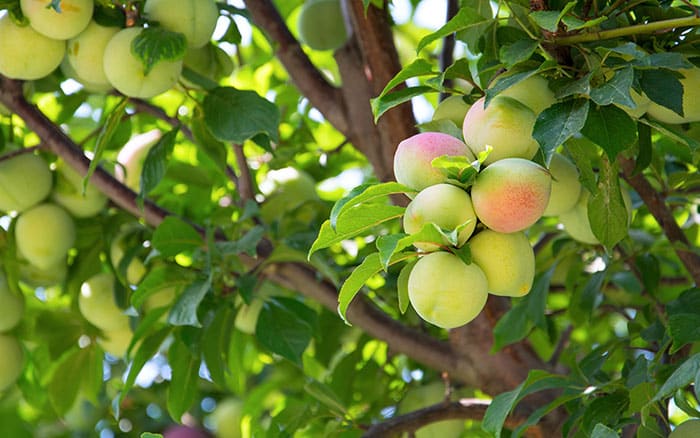Plum trees are a fantastic and reliable tree to have in the garden. Plums are grown on every continent except for Antarctica, so find out how to grow your own plums in your garden here.
They are perfect for smaller gardens, and many types are self-fertile, so you don’t need huge amounts of space for pollinating partners.
Planting plums
Firstly, the ideal time to plant plum trees is between November and March, when they are dormant. They can be grown in containers, but ensure the container is large enough so it doesn’t dry out too quickly in summer.
Alternatively, when planting in the ground, bear in mind that they are quite thirsty plants, so good clay or loam soil are best.

Although, waterlogged soil isn’t good, so they need a well-drained spot. If your soil is particularly sandy or chalky, work in plenty of organic matter before planting.
Plum trees are hardy, but the flowers can be vulnerable to frosts. Therefore, it’s vital to keep the tree out of exposed, windy sites and frost pockets.
A great variety to grow is ‘Victoria’ which is known for its heavy crops of delicious fruits that are perfect for picking and eating straight from the tree, or using in jams and preserves. What’s more, they are self-fertile and have a compact habit and are therefore perfect for small and medium gardens.
Take care

To care for the vulnerable flowers, you can cover the trees with horticultural fleece. Do this by draping the fleece over supportive canes so the fleece doesn’t touch the flowers.
When the tree is established, in spring apply well-rotted farmyard manure as a mulch. This will keep down weeds, retain moisture, as well as providing nitrogen to boost growth.
Plum trees don’t require as much pruning to apples and pears. But when pruning it is best to carry out this task in spring or summer because winter pruning can increase the risk of plums being infected.
Use the secateurs to cut back the current season’s growth to the main shoots by cutting them back to half their length. Also, prune away the side shoots to two or three buds.
Pick your plums
The fruit is usually set in early summer and will begin to swell, ready for harvesting around August and September.
In mid to late summer, it can be useful to prop up the branches and give them a bit more support because the weight of the fruit can result in the branches snapping.
Plum trees are reliable for producing fruit, and you can further increase yield by feeding in early spring with a balanced fertiliser and watering regularly.

A fertiliser that’s high in nitrogen is good too because plum trees can grow such heavy crops. For that reason it is also beneficial to harvest some of the formed fruits in June and July to ensure the tree isn’t overloaded.
With the remaining fruits, pick them when they feel soft to the touch and pull away from the tree with ease.
Not only will the taste of homegrown plums satisfy your tastebuds, but they will also provide you with plenty of nutrients. A good source of vitamin C, A, and K, they are also rich in calcium, which ensures blood clots normally and magnesium which helps to reduce fatigue.

Leave A Comment